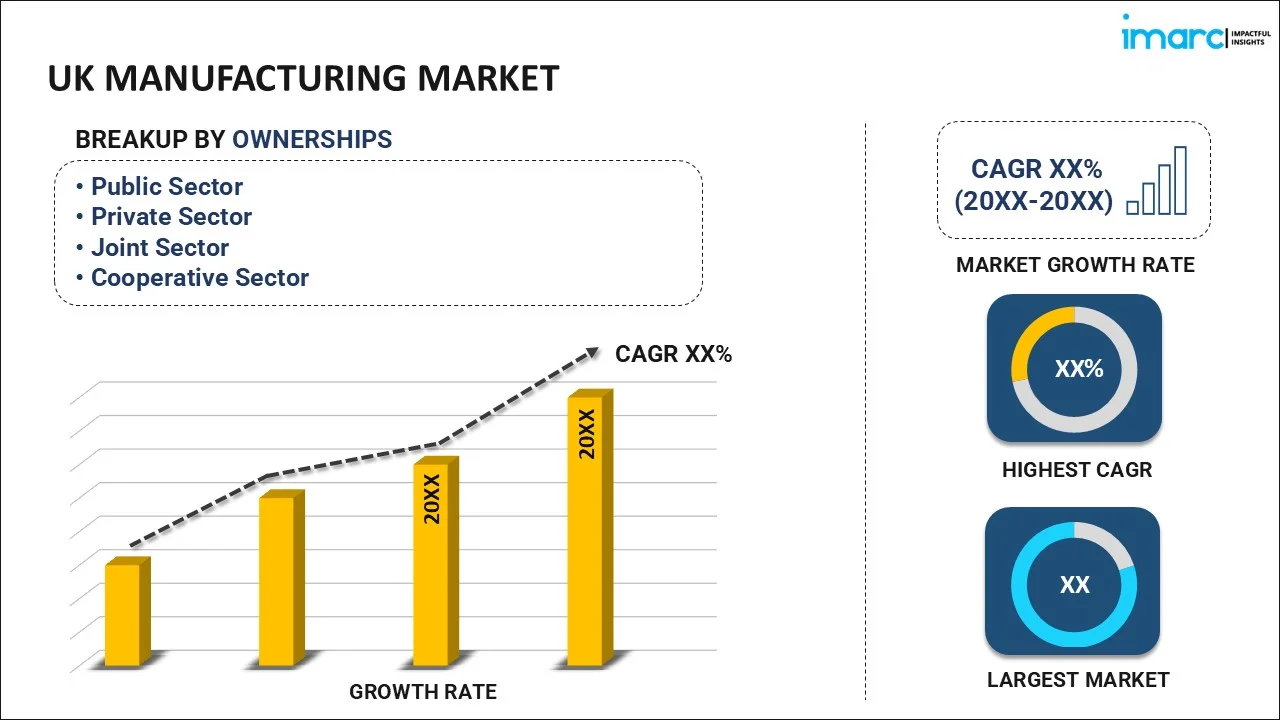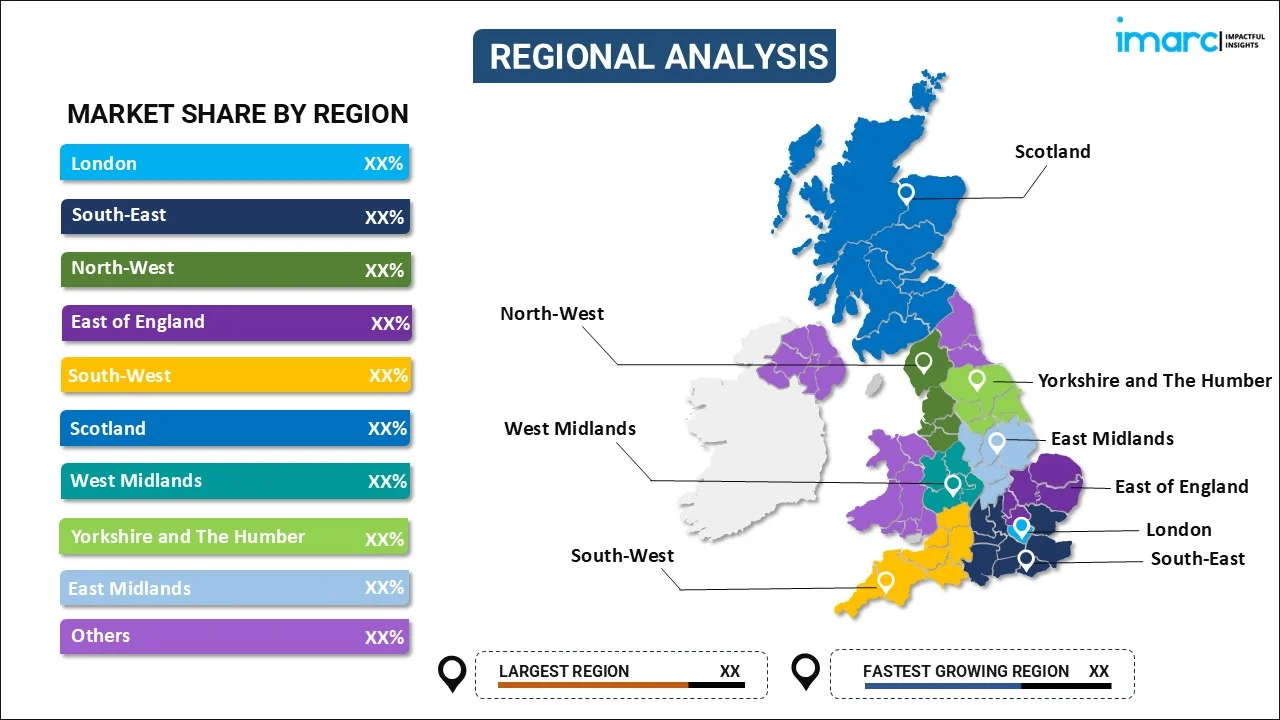
UK Manufacturing Market Size, Share, Trends and Forecast by Ownership, Raw Materials Used, End-User Industries, and Region, 2025-2033
UK Manufacturing Market Size and Share:
The UK manufacturing market size reached USD 587.20 Billion in 2024. Looking forward, IMARC Group expects the market to reach USD 1,356.20 Billion by 2033, exhibiting a growth rate (CAGR) of 8.70% during 2025-2033. Factors like continuous technological breakthroughs, rising demand for automation, supportive government policies, extensive investments in innovation, increased consumer spending, a trained workforce, and improvements in supply chain efficiency are impelling the market growth.
|
Report Attribute
|
Key Statistics
|
|---|---|
|
Base Year
|
2024
|
|
Forecast Years
|
2025-2033
|
|
Historical Years
|
2019-2024
|
| Market Size in 2024 | USD 587.20 Billion |
| Market Forecast in 2033 | USD 1,356.20 Billion |
| Market Growth Rate (2025-2033) | 8.70% |
UK Manufacturing Market Trends:
Technological Advancements
A technological renaissance is taking place in manufacturing in the UK for more efficiency, precision, and productivity. Latest technologies, including IoT, AI, and ML, are triggering the shift from conventional manufacturing to advanced manufacturing processes. Real-time data collection from machinery via IoT sensors and devices allows predictive maintenance to optimize machine uptime. AI and ML algorithms analyze data to optimize production schedules, minimize waste, and ensure quality control. Further, developments in additive manufacturing or 3D printing allow for accelerated prototyping and customized production, resulting in reduced lead times and costs. For instance, in May 2024, Darwen, UK, approved a £100 million manufacturing and research center, featuring the UK's first Additive Manufacturing Accelerator, supported by Barnfield Construction, Blackburn Council, and the University of Sheffield’s AMRC. These technological improvements not only enhance operational efficiency but also foster innovation in product development and manufacturing techniques.
Rise of Automation
Automation is the major trend one observes in the growth of the UK manufacturing market. The automation of workplaces has seen increased production levels as repetitive processes are undertaken automatically by robots and machines, significantly reducing human error. Hence, it releases human hands from simple but repetitive tasks to turn their attention to the more complex and valuable ones. This is especially seen in industries such as automotive and electronics, which have high-volume production and intricate assembly tasks appropriate for automation. For instance, in February 2025, Artimus Robotics secured £1.5M in funding from the UK government’s ARIA to advance its soft actuation technology and collaborate with the University of Bristol on dexterous manipulators. Furthermore, the implementation of automated guided vehicles (AGVs) and conveyor systems enhances logistics and material handling within manufacturing facilities. The rise of Industry 4.0, characterized by the integration of cyber-physical systems, is also contributing to this trend, as smart factories leverage interconnected systems to optimize operations and improve efficiency.
Focus on Sustainability
Sustainability is becoming increasingly important in the UK manufacturing industry as businesses attempt to comply with environmental requirements and customer expectations. There is a rising emphasis on lowering carbon footprints, decreasing waste, and applying circular economy concepts. Manufacturers are investing in environmentally friendly technology and procedures, including energy-efficient machinery and renewable energy sources. For instance, in February 2025, the UK Government will allocate £200 million to plan the future of Grangemouth, as its oil refinery closes and transitions to an import terminal, potentially impacting 400 jobs. Adopting sustainable practices not only helps a firm comply with severe environmental rules, but also improves its reputation and appeals to environmentally sensitive customers. For example, the use of recycled materials in manufacturing and the creation of items intended for reuse or recycling are becoming more frequent. Furthermore, corporations are looking for strategies to cut energy usage and enhance resource efficiency, which will help them achieve their sustainability goals, which is further impelling the market growth.
UK Manufacturing Market Segmentation:
IMARC Group provides an analysis of the key trends in each segment of the market, along with forecasts at the region/country level for 2025-2033. Our report has categorized the market based on ownership, raw materials used, and end-user industries.
Ownership Insights:

- Public Sector
- Private Sector
- Joint Sector
- Cooperative Sector
The report has provided a detailed breakup and analysis of the market based on the ownership. This includes public sector, private sector, joint sector, and cooperative sector.
Raw Materials Used Insights:
- Agro Based Industries
- Minerals Based Industries
A detailed breakup and analysis of the market based on the raw materials used have also been provided in the report. This includes agro based industries and minerals based industries.
End-User Industries Insights:
- Automotive
- Manufacturing
- Textile and Apparel
- Consumer Electronics
- Construction
- Foods and Beverages
- Others
A detailed breakup and analysis of the market based on the end user industries have also been provided in the report. This includes automotive, manufacturing, textile and apparel, consumer electronics, construction, foods and beverages, and others.
Regional Insights:

- London
- South East
- North West
- East of England
- South West
- Scotland
- West Midlands
- Yorkshire and The Humber
- East Midlands
- Others
The report has also provided a comprehensive analysis of all the major UKal markets, which include London, South East, North West, East of England, South West, Scotland, West Midlands, Yorkshire and The Humber, East Midlands, and Others.
Competitive Landscape:
The market research report has also provided a comprehensive analysis of the competitive landscape. Competitive analysis such as market structure, key player positioning, top winning strategies, competitive dashboard, and company evaluation quadrant has been covered in the report. Also, detailed profiles of all major companies have been provided.
UK Manufacturing Market News:
- In September 2024, Exeter Trade Aluminium announced a partnership with Alunet Systems, supplying their ALUNA Aluminium Doors, Windows & Roof Lights across Devon, Cornwall and the South West. The ALUNA range combines beautiful, ultra-modern designs with expert manufacturing without compromising product quality or reliability.
- In March 2023, PA Consulting and Swedish R&D firm PulPac formed the Bottle Collective to design a new fibre-based alternative to single-use plastic bottles. PulPac, known for its patented manufacturing technology, Dry Molded Fiber, creates low-cost, high-performance fibre-based packaging and single-use products.
UK Manufacturing Market Report Coverage:
| Report Features | Details |
|---|---|
| Base Year of the Analysis | 2024 |
| Historical Period | 2019-2024 |
| Forecast Period | 2025-2033 |
| Units | Billion USD |
| Scope of the Report |
Exploration of Historical Trends and Market Outlook, Industry Catalysts and Challenges, Segment-Wise Historical and Future Market Assessment:
|
| Ownerships Covered | Public Sector, Private Sector, Joint Sector, Cooperative Sector |
| Raw Materials Used Covered | Agro Based Industries, Minerals Based Industries |
| End-User Industries Covered | Automotive, Manufacturing, Textile and Apparel, Consumer Electronics, Construction, Foods and Beverages, Others |
| Regions Covered | London, South East, North West, East of England, South West, Scotland, West Midlands, Yorkshire and The Humber, East Midlands, Others |
| Customization Scope | 10% Free Customization |
| Post-Sale Analyst Support | 10-12 Weeks |
| Delivery Format | PDF and Excel through Email (We can also provide the editable version of the report in PPT/Word format on special request) |
Key Questions Answered in This Report:
- How has the UK manufacturing market performed so far and how will it perform in the coming years?
- What is the breakup of the UK manufacturing market on the basis of ownership?
- What is the breakup of the UK manufacturing market on the basis of raw materials used?
- What is the breakup of the UK manufacturing market on the basis of end-user industries?
- What is the breakup of the UK manufacturing market on the basis of region?
- What are the various stages in the value chain of the UK manufacturing market?
- What are the key driving factors and challenges in the UK manufacturing?
- What is the structure of the UK manufacturing market and who are the key players?
- What is the degree of competition in the UK manufacturing market?
Key Benefits for Stakeholders:
- IMARC’s industry report offers a comprehensive quantitative analysis of various market segments, historical and current market trends, market forecasts, and dynamics of the UK manufacturing market from 2019-2033.
- The research report provides the latest information on the market drivers, challenges, and opportunities in the UK manufacturing market.
- Porter's five forces analysis assist stakeholders in assessing the impact of new entrants, competitive rivalry, supplier power, buyer power, and the threat of substitution. It helps stakeholders to analyze the level of competition within the UK manufacturing industry and its attractiveness.
- Competitive landscape allows stakeholders to understand their competitive environment and provides an insight into the current positions of key players in the market.
Need more help?
- Speak to our experienced analysts for insights on the current market scenarios.
- Include additional segments and countries to customize the report as per your requirement.
- Gain an unparalleled competitive advantage in your domain by understanding how to utilize the report and positively impacting your operations and revenue.
- For further assistance, please connect with our analysts.
 Request Customization
Request Customization
 Speak to an Analyst
Speak to an Analyst
 Request Brochure
Request Brochure
 Inquire Before Buying
Inquire Before Buying




.webp)




.webp)












